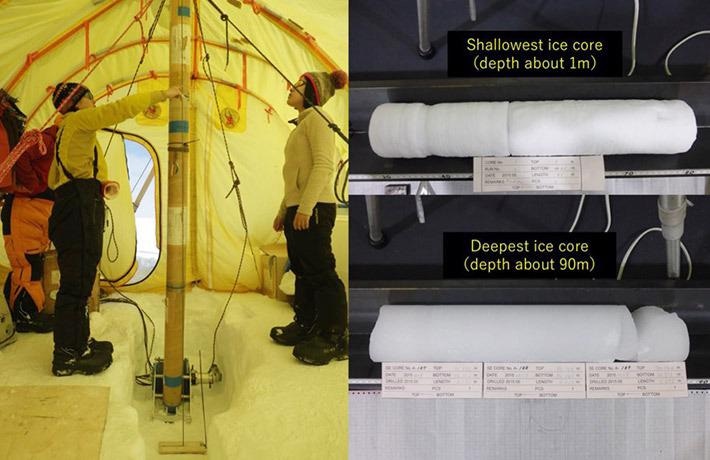Jun 1 2021
Ice core data obtained from Greenland indicates why air pollution has been decreasing slower compared to reductions in sulfur emissions.
 The researchers in the drilling operation (left) and the drilled samples (right). Image Credit: Hokkaido University
The researchers in the drilling operation (left) and the drilled samples (right). Image Credit: Hokkaido University
When cloud droplets turn out to be less acidic, the chemical reaction that converts sulfur dioxide into sulfate aerosol becomes more effective. These findings can enhance the models that predict climate change and air quality.
In the United States and Western Europe, the air is much cleaner compared to how it was a decade ago. Low-sulfur gasoline standards and regulations on power plants have been successful in cutting sulfate concentrations in the air, thereby decreasing the fine particulate matter that tends to impact human health and cleaning up the environmental risk of acid rain.
In spite of these victories, sulfate levels in the air have dropped more slowly compared to sulfur dioxide emissions, particularly during wintertime. This surprising phenomenon indicates that reductions in sulfur dioxide emission are less efficient than anticipated for cutting sulfate aerosols.
A new study headed by the Tokyo Institute of Technology (Tokyo Tech), Hokkaido University, and the University of Washington describes why. The open-access paper was published in the Science Advances journal on May 5th, 2021.
When acidic sulfate concentrations from fossil fuel emissions reduce while more basic ammonium molecules concentration in the air stays persistent, liquid water droplets in clouds turn out to be less acidic.
This makes sulfur dioxide to sulfate conversion more effective. Therefore, although air quality regulations have decreased the delivery of sulfur dioxide from power plants and shipping, the entire amount of sulfate particulates that tend to affect human health has declined more gradually.
“This does not mean that the emissions reductions aren’t working. It’s just that there is a reaction which partially mitigates the reductions. We need to understand this multiphase chemistry in the atmosphere to design an efficient strategy to manage air pollution and accurately predict future air pollution and climate change impacts.”
Becky Alexander, Study Co-Author and Professor of Atmospheric Sciences, University of Washington
For the most part of the 20th century, there was an increase in sulfur dioxide emissions due to industrialization in several parts of the world. However, in recent times, that trend has been inverted thanks to regulations, though ammonium emissions from agriculture and animals remain at the same rate. These trends are anticipated to continue.
Data obtained from an ice core in Greenland that conserves past years’ atmospheres indicates that the proportion of sulfate-containing oxygen with one additional neutron, or oxygen-17, increased in the 1980s when countries started to control emissions.
The investigation by the researchers demonstrates this has been caused as a result of quicker sulfate formation in the liquid phase in the air, which takes place mostly inside clouds, under less-acidic conditions.
“After the SO2 emission control, relatively lower atmospheric acidity promotes the efficiency of sulfate production in the atmosphere, which weakens the response of sulfate level to the SO2 reduction. Our unique isotopic techniques applied for the Greenland ice core records identify the key process of the weakened response of sulfate to SO2 emissions reduction.”
Shohei Hattori, Study Lead Author, Tokyo Institute of Technology
The data was obtained from an ice core drilled in southeast Greenland (SE-Dome) as part of a project headed by Hokkaido University. The oxygen captured within this ice offered proof of sulfate composition from 1959 to 2015, without any contamination from local pollution.
“Based on a continuous and high-resolution ice core record from se-dome, we could obtain reliable records for atmospheric aerosols without second modification after deposition. We plan to drill a second ice core at the same location this year, and try to reconstruct the aerosol history back to the 1750s.”
Yoshinori Iizuka, Study Co-Author and Leader of SE-Dome Ice Core Project, Hokkaido University
Although the ice core did not include separate data for summer and winter, models indicate that other, gas-phase chemical reactions for sulfur dioxide turn out to be more crucial in summer, thereby decreasing the summertime effect of altering cloud acidity. Being aware of how such molecules react will help enhance the atmospheric models employed to project climate change and predict air quality.
This study was financially supported by the Japan Ministry of Education, Culture, Sports, Science and Technology (MEXT) and Japan Society for the Promotion of Science (JSPS) KAKENHI (grant numbers JP16H05884, JP18H05292, JP17H06105, JP18H03363, JP20H04305).
This research formed part of Joint Research and the Leadership programs carried out by the Institute of Low Temperature Science, Hokkaido University, and Arctic Challenge for Sustainability II (ArCS II; Program Grant Number JPMXD1420318865) research project.
Journal Reference:
Hattori, S., et al. (2021) Isotopic evidence for acidity-driven enhancement of sulfate formation after SO2 emission control. Science Advances. doi.org/10.1126/sciadv.abd4610.